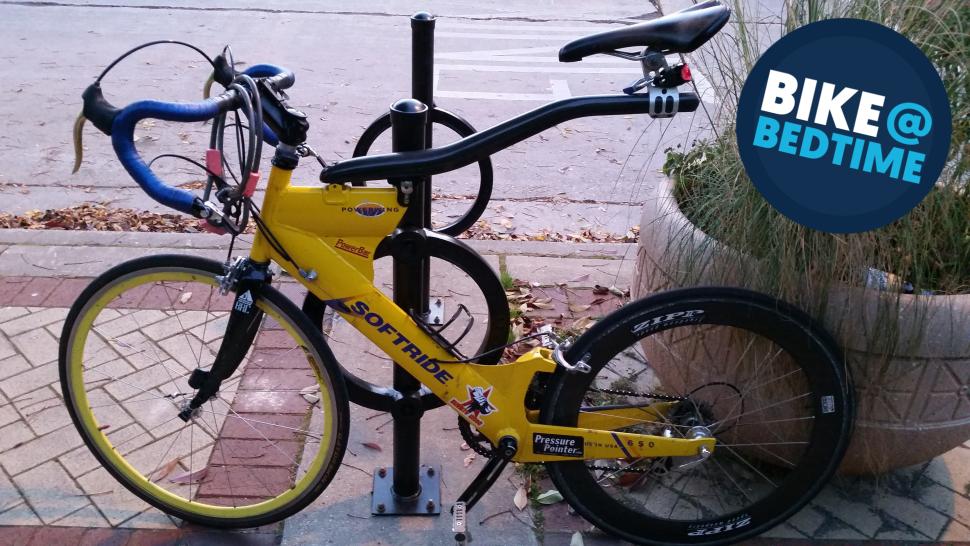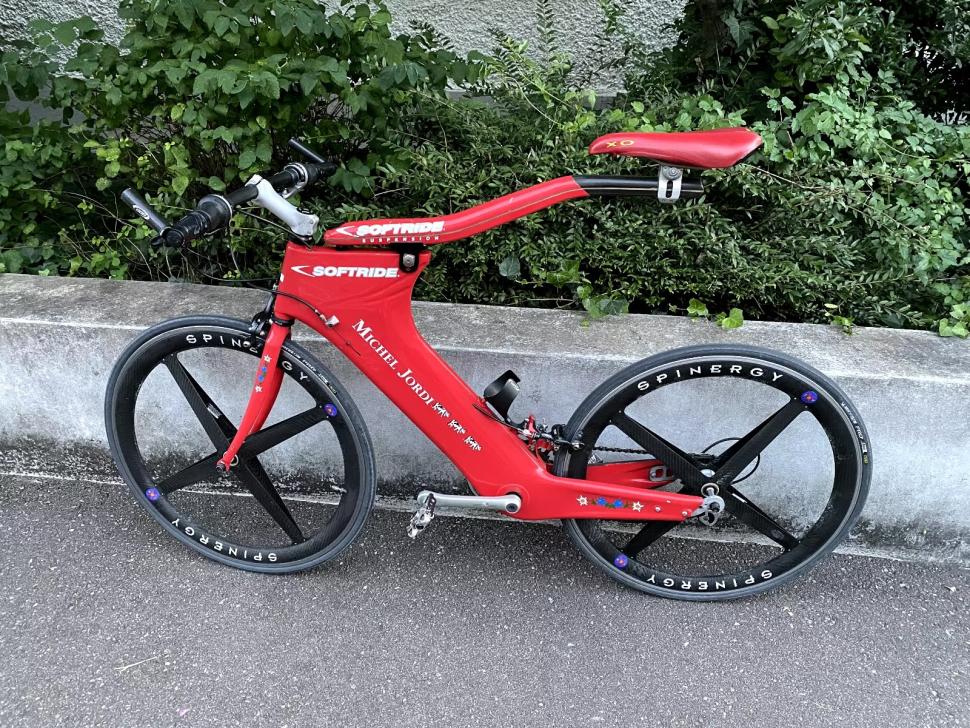- News
- Reviews
- Bikes
- Accessories
- Accessories - misc
- Computer mounts
- Bags
- Bar ends
- Bike bags & cases
- Bottle cages
- Bottles
- Cameras
- Car racks
- Child seats
- Computers
- Glasses
- GPS units
- Helmets
- Lights - front
- Lights - rear
- Lights - sets
- Locks
- Mirrors
- Mudguards
- Racks
- Pumps & CO2 inflators
- Puncture kits
- Reflectives
- Smart watches
- Stands and racks
- Trailers
- Clothing
- Components
- Bar tape & grips
- Bottom brackets
- Brake & gear cables
- Brake & STI levers
- Brake pads & spares
- Brakes
- Cassettes & freewheels
- Chains
- Chainsets & chainrings
- Derailleurs - front
- Derailleurs - rear
- Forks
- Gear levers & shifters
- Groupsets
- Handlebars & extensions
- Headsets
- Hubs
- Inner tubes
- Pedals
- Quick releases & skewers
- Saddles
- Seatposts
- Stems
- Wheels
- Tyres
- Health, fitness and nutrition
- Tools and workshop
- Miscellaneous
- Tubeless valves
- Buyers Guides
- Features
- Forum
- Recommends
- Podcast
feature
 Image Wiki Commons AndrewBressel
Image Wiki Commons AndrewBresselSoftride: extraordinary suspension tech that never stuck
Softride bikes with built-in shock absorption were touted as The Next Big Thing back in the 1990s, but these days they’re regarded by most as a quirky curiosity from yesteryear. What happened
It would be slightly unfair to say that the Softride concept never caught on because it did have a brief moment in the sun.
Every year since 1992 at the Ironman World Championships in Hawaii, a survey of the bikes ridden has been conducted. It’s a lot of fun. Back in 1996, out of 857 bikes, 126 were Softrides. To save you doing the maths, that’s nearly 15%. Only fellow US brands Trek and Cannondale had a higher representation (151 and 150 bikes, respectively). Granted, the triathlon market at the time was small, and the Ironman slice of that sector was even slimmer, but still, Softride was gaining followers.
In 1993, Jugen Zack set a new bike course record at the Ironman World Championships on a Softride, and in 1994 Greg Welch rode one on his way to winning the event outright. Softride was never the biggest thing in cycling – not even close – but it was a part of the landscape, particularly in triathlon, for a while back there.
The Softride Suspension System was introduced to the world back in 1989 and the company produced its PowerCurve mountain bike in 1991. Softride released the Classic TT, its first aluminium-framed bike for the road, in 1996, and more models came along later.
Pic: Zipp 2001 TT bike from 1993 (Sram.com)
Zipp also built bikes that looked vaguely similar in the 1990s, although the flex here came courtesy of a hinge rather than being inherent in the beam itself. There have been plenty of other bikes without seat tubes or seatstays, such as the Cervelo P5X and P3X in more recent years.
So what was the point?
Pic: ebay
The main idea of the Softride design was to add plushness to the ride – the clue’s in the name. The beam was designed to flex slightly to isolate you from vibration and bumps. These days, we’re used to big brands like Specialized telling us that “smoother is faster”, but the concept wasn’t as mainstream back then.
The idea is that the smoother the ride, the quicker you can go. Plus, high-frequency vibration can lead to muscle soreness, and that’s a big deal when you’re effectively time-trialling 112 miles (180km) after a 2.4 mile (3.8km) swim and before running a full marathon. On top of that, the lack of a seat tube or seatstays was said to reduce drag.
Did the Softride design work?
Well, it did soften the ride, yes, so in that sense it worked.
However, it was an odd experience. First of all, when you climbed aboard and sat down, the beam would sink a little under your weight. Not much, but enough to notice. You needed to take that into account when setting up the bike (you could alter the saddle height by adjusting the angle of the beam).
Also, the beam could bob as a result of your movement, although this was partly down to your pedalling technique. The beam wouldn’t bob if you span perfectly smooth circles with your feet, but the further away you got from that, the more likely it became. Some riders saw this as a positive characteristic to help improve pedal stroke. Beam movement could also occur if you didn’t have the saddle set at the right height.
Many people couldn’t get on with these idiosyncrasies but others could. Softride certainly had its fans, mainly among triathletes who would often praise the speed. Fair enough, crosswinds were sometimes a problem because of the very deep head tube and down tube, but straight-line speed could be impressive.
Softride as a company still exists but it no longer makes bikes. The UCI announced that bikes not conforming to a traditional double-diamond design would be banned in road racing from 2000. They were still permitted in triathlon, though. In fact, they still are, although Softride hasn’t produced bikes since 2007.
Cervelo (mentioned above) is no longer making bikes without seat tubes and seatstays, but Dimond, for example, offers plenty of options for the triathlon market, albeit with top tubes that aren’t designed to flex, and Ceepo still makes its Shadow model, again for triathlon.
Flexy carbon beams, though? We’re not expecting a comeback anytime soon.
Mat has been in cycling media since 1996, on titles including BikeRadar, Total Bike, Total Mountain Bike, What Mountain Bike and Mountain Biking UK, and he has been editor of 220 Triathlon and Cycling Plus. Mat has been road.cc technical editor for over a decade, testing bikes, fettling the latest kit, and trying out the most up-to-the-minute clothing. He has won his category in Ironman UK 70.3 and finished on the podium in both marathons he has run. Mat is a Cambridge graduate who did a post-grad in magazine journalism, and he is a winner of the Cycling Media Award for Specialist Online Writer. Now over 50, he's riding road and gravel bikes most days for fun and fitness rather than training for competitions.
Latest Comments
- Will Ive Hook 4 hours 29 min ago
I got a pair for fifty quid a few weeks ago and they are a gorgeeous fit. If I'd paid £210, they'd still be in the box. I sized down from extra...
- PoorInRichfield 5 hours 1 min ago
While they're at it, why not combine 105 and Ultegra into a single group set?...
- Sredlums 5 hours 35 min ago
Exactly what I was wondering. How do you KNOW how much it deviates. What kind of setup is used, what devices are used, and does that accurately...
- mikeclarke 6 hours 37 min ago
Think those roads are bad? Have a look at the road between Northwood and Bettisfield. All the minor roads on the Shropshire Wales border are in a...
- Malv173 7 hours 49 min ago
You a Sun writer? Rabid tribalism wasn't responsible for the Hillsborough disaster. Poor policing and management of the crowds, including stadium...
- belugabob 8 hours 7 min ago
If you take a look at Google maps street view, from the Bush lane end, you'll see that there already seems to be hedges, either side of what looks...
- ktache 8 hours 46 min ago
Bonus for buses and lorries hitting bridges?
- roboito 9 hours 35 min ago
I had this on my Forerunner 955 yesterday, needed a hard reset. The instructions were on the Garmin website. A time wasting annoyance but easily...
- Rendel Harris 10 hours 2 min ago
I dunno, they complain that they spend all this money on cycle lanes and nobody uses them and then one does and...


Add new comment
3 comments
I've seen one on the back of a tandem, where it makes a lot of sense.
https://www.tandemclassifieds.com/tandem_bikes_for_sale.php?bike=2023_10...
https://bikesnobnyc.com/2023/03/07/soft-rides-demand-hard-people/
Shame that the bike seemed to perform so poorly as I like the almost retro-futurism look of them. However, there's good reasons why the double triangle frame is king.